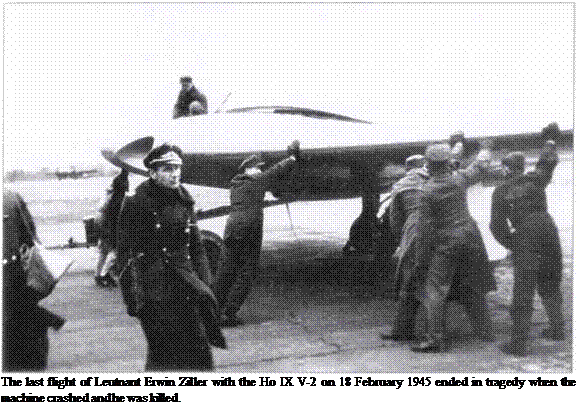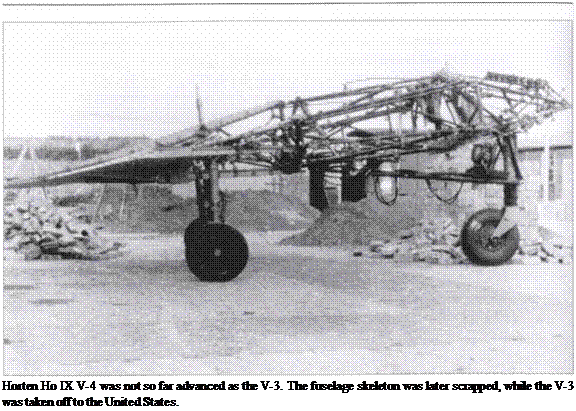Searchingfor Superior Ideas
At the end of 1944 it was clear that many promising projects were not yet ready for service. By the harshest work measures, including the construction of ever
more satellite camps and annexes of existing concentration camps, Himmler attempted to bring about a crucial change at the eleventh hour. Intensive efforts were made to produce fighter-bombers in which great hopes had been placed. The later Horten Go-229 A-l design was less a fighter-bomber than a promising cross between a fighter and a Jabo armed with two ETC 503s. The SS believed that this Kampfjager (‘battle fighter’) was in itself a powerful fighter by its speed and manoeuvrability, but the design was problematical for many. The ‘flyingwing’ (.Nurfliigel) was elegant but not easy to fly. The use of jet turbines and rejection of the traditional tailplane did not help the attitude of the Go-229 in flight, and the indifferent BMW and Jumo turbines of early 1945 would have kept the aircraft out of operations.

At the beginning of the war, Hans Multopp, who was working on the development of the Та 183 at Focke-Wulf, opposed the idea of flying-wing fast bombers because they were not capable of carrying heavy bomb-loads. A further objection to flying-wing fighters was that if one or both turbines failed the aircraft would immediately become uncontrollable. As well as the designs and constructions of the brothers Reimar and Walter Horten at Gotha, Arado, BMW
(Messerschmitt) and Focke-Wulf in particular produced numerous studies for all-weather fighters of this kind. None had any possibility of being realised towards the end because resources were exhausted.
Horten Но IX (Go-229)
The Kampjjager concept fitted the flying-wing designs of the Horten brothers. Their Но IX (Gotha Go 229) was a highly efficient machine intended to complement the Me 262 as the front-line fighter pairing from the beginning of 1945.

During the 1930s the Horten brothers had experimented successfully with the construction of flying-wing type aircraft. The Go 229 was not a pure fighter but a ‘heavy fighter’. Development of the machine under the works specification Но IX proceeded initially at Luftwaffenkommando IX at Gottingen. The first prototype V-l received an RLM number and was reclassified as Ho 229 V-l. The second prototype Но IX V-2 had two Jumo 004B turbines. Test pilot Leutnant Erwin Ziller probably made a few flights with this machine before the ‘official’maiden flight on 2 February 1945. Shortly before landing on 18 February

a turbine failed and in the attempted emergency touchdown the aircraft hit the ground too fast and somersaulted, killing Ziller.
At the beginning of 1945 work began on prototypes V-3 to V-5 at Friedrichsroda near Gotha. As Horten did not have sufficient assembly capacity, the Chief-TLR ordered 20 machines, now designated Go 229 A-l, built at Gotha Waggonfabrik and at Klemm, Boblingen. Because of the shortage of reconnaissance jets, some of these 20 were to be produced as ‘attack reconnaissance’ aircraft (Gewaltaufklarer). The original armament of four MK 108s was reduced to two and two Rb 50/18 cameras installed for overlapping-frame photography. All later aircraft were to have four MK 103 fixed guns to free MK 108 production for the Me 262. When the US 9th Armored Division advanced on Gotha, it captured the almost complete Go 229 V-3 and the early-stage fuselages of the V-4 and V-5 similar to V-2, and V-6. V-3 was dismantled and shipped to the USA for testing.
Go 229 V-6 was the precursor of the series type A-l having a thicker profile with partially armoured cockpit and various weapon combinations. The common assumption that it was a two-seater is incorrect. Go 229 A-l was to be the Gotha series-built aircraft resembling the Но IX outwardly, but modified in nearly all
details by Gotha. On 4 April 1945 the Chief-TLR decided that apart from prototypes V-3 to V-5, prototypes V-6 to V-15 were to be built at Gotha before the series run started. Despite the war situation, it was still intended to turn out a series of 100 Go 229 A-Is, but based on the Gotha project P-60, from which the Chief-TLR expected a better performance, The P-60 was planned as a heavy fighter with two recumbent crew. The design continued into April 1945 because the Go 229 formed part of the Emergency Programme.










